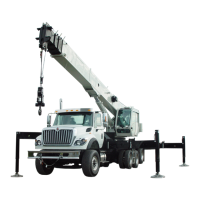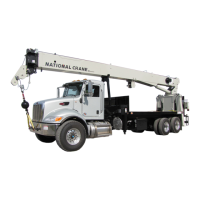1-22 Published 8-01-2017 Control # 287-11
INTRODUCTION NBT40 SERVICE MANUAL
HOIST CABLE INSPECTION AND
MAINTENANCE
Hoist Rope
Crane may be equipped with synthetic hoist rope or wire
rope. Hoist rope may be purchased through Manitowoc
Crane Care.
For detailed information concerning synthetic hoist rope,
refer to K100 Synthetic Crane Hoist Line Manual P/N
9828100734 available by contacting Manitowoc Crane Care.
During installation and setup, care must be taken to avoid
overlap and crossing of wire rope and synthetic hoist ropes.
Ensure that crane surfaces such as wear pads, sheaves, etc
have not been damaged in a manner that can then damage
the synthetic hoist rope.
Hoist rope should be inspected frequently/daily and
periodically/yearly in accordance with the following
information excerpted from a National Consensus Standard
as referenced by Federal Government Agencies.
Recommended inspection intervals may vary from machine
to machine and may vary based on environmental
conditions, frequency of lifts, and exposure to shock loads.
The inspection time intervals may also be predetermined by
state and local regulatory agencies.
Any deterioration observed in the hoist rope should be noted
in the equipment inspection log and an assessment
concerning hoist rope replacement should be made by a
qualified person.
Keeping Records
A signed and dated report of the hoist rope condition at each
periodic inspection must be kept on file at all times. The
report must cover all inspection points listed in this section.
The information in the records can then be used to establish
data which can be used to determine when a hoist rope
should be replaced.
It is recommended that the hoist rope inspection program
include reports on the examination of wire rope removed
from service. This information can be used to establish a
relationship between visual inspection and the rope’s actual
internal condition at the time of removal from service.
WIRE ROPE
General
The following information includes inspection, replacement,
and maintenance guidelines for wire rope as established by
ANSI/ASME B30.5, federal regulations, and National
Manitowoc specifications. The inspection interval shall be
determined by a qualified person and shall be based on
expected rope life as determined by experience, severity of
environment, percentage of capacity lifts, frequency of
operation, and exposure to shock loads. Periodic inspections
need not be at equal calendar intervals and should be
performed at shorter time intervals as the wire rope
approaches the end of its useful life. A periodic inspection
shall be performed at least once a year. The following
information contains inspection and maintenance
procedures for wire ropes used on National products as load
lines, hoisting cables, boom extension and retraction cables,
pendant cables, and hook block tie down cables.
Environmental Conditions
The life expectancy of wire rope may vary due to the degree
of environmental hostility. Variation in temperature,
continuous excessive moisture levels, exposure to corrosive
chemicals or vapors, or subjecting the wire rope to abrasive
material can shorten wire rope life. Frequent inspections and
maintenance of the wire rope is recommended for preventing
premature wear and to insure long-term performance.
Dynamic Shock Loads
Subjecting wire rope to abnormal loads shortens the ropes
life expectancy. Examples of this type of loading are as
follows:
• High velocity movement followed by abrupt stops
(hoisting or swinging of a load).
• Suspending loads while traveling over irregular surfaces
such as railroad tracks, potholes, and rough terrain.
• Moving a load that is beyond the cranes rated capacity.
Lubrication
The object of rope lubrication is to reduce internal friction and
to prevent corrosion. New lubricant needs be added
throughout the life of the rope. It is important that lubricant
applied needs to be compatible with the original lubricant.
Consult the rope manufacturer for proper lubricant. The
lubricant applied shall be of the type which does not hinder
visual inspection. Those sections of rope which are located
over sheaves or otherwise hidden during inspection require
special attention when lubricating rope.
During fabrication, ropes receive lubrication which provides
the rope with protection for a reasonable time if stored under
proper conditions. After the rope is put into service, periodic
WARNING
Worn or Damaged Equipment Hazard!
Never use a worn or damaged hoist rope. Death or
serious injury could result from using worn or damaged
hoist rope.
Reference Only

